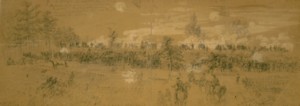Glendale/Malvern HIll Battlefields Visitor Center
Introduction
Text-to-speech Audio
Images
The Glendale/Malvern Hill Battlefields Visitor Center. The Center is in the background

The historical marker for the Battle of Glendale.

An interpretive display within the visitor center featuring an Enfield rifle.

Various artillery shells on display.

Alfred R. Waud's sketch for Harper's Weekly. This was done as fighting raged along the Charles City Road during the Battle of Glendale

Don Troiani's "The Southern Cross" depicts a scene of heavy fighting during the Battle of Glendale

Backstory and Context
Text-to-speech Audio
The Battles of Glendale (or Frayser’s Farm) and Malvern Hill were both part of the larger Seven Days Battle which was a series of six battles that took place over seven days from 25 June through 1 July 1862. Likewise, the Seven Days Battle was part of the larger Union Army of the Potomac’s Peninsula Campaign, during which Union forces attempted to capture the Confederate capital of Richmond. After their attempts failed, and face with a constant barrage of Confederate attacks and maneuvers, the Union army retreated back down the Peninsula formed by the James and York River. General Lee’s Army of Northern Virginia attempted to prevent that retreat.
The Battles of Glendale and the culminating battle of Malvern Hill were the last two of the Seven Days Battle. The Battle of Glendale (June 30) was probably Lee’s best chance to prevent the Union army from reaching the James. However, a series of communication and tactical errors allowed the Union forces to escape and establish a defensive position on Malvern Hill (July 1).
On 1 July 1862, the entrenched Union forces on Malvern Hill were able to repel multiple Confederate assaults due largely to the effectiveness of their artillery. After the battle, Lee allowed his exhausted army to rest while Union General George McClellan continued his retreat to Harrison’s Landing, where he was protected by the Union navy and Union-controlled Fortress Monroe, essentially ending the Peninsula Campaign.
